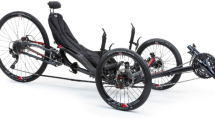Abstract
Exoskeleton robots are used to augment human power to perform difficult tasks. These robots can generate eternal load on human muscles as training devices. In this paper, a lower-limb training device using exoskeleton is developed for muscle power augmentation during cyclic motion. A control system determines augmenting power on the human leg during pedaling motion based on the calculation of muscle activity timing. The resulting power of the exoskeleton assists cycling motion as a rehabilitation system or applies mechanical load on the leg muscles as a training system. Measurement of interaction force by the load cell on each pedal determines admittance control signal. Experiments to assist bicycle riding motion using the developed exoskeleton were conducted. From the interaction force analysis, the sources of errors in the motion control are found, and the application-specific problems are discussed. Given that the exoskeleton robot can control hip and knee joint independently, the proposed system can be extended for assisting various motions in daily life, including walking rehabilitation.
Similar content being viewed by others
Abbreviations
- L i :
-
Length of i-th link
- l i :
-
Distance to center of gravity from the i-th frame origin
- θ 0i :
-
Direction to center of gravity from the i-th frame origin
- m i :
-
mass of i-th link
- I izz :
-
Moment of inertia of i-th link
- θ i,j :
-
sum of two angles, θ i+ θ j
References
Chu, A., Kazerooni, H., and Zoss, A., “On the Biomimetic Design of the Berkeley Lower Extremity Exoskeleton (BLEEX),” Proc. of the IEEE International Conference on Robotics and Automation, pp. 4345–4352, 2005.
Pratt, J. E., Krupp, B. T., Morse, C. J., and Collins, S. H., “The Roboknee: An Exoskeleton for Enhancing Strength and Endurance during Walking,” Proc. of IEEE International Conference on Robotics and Automation, vol. 3, pp. 2430–2435, 2004.
Hayashi, T., Kawamoto, H., and Sankai, Y., “Control Method of Robot Suit HAL Working as Operator’s Muscle using Biological and Dynamical Information,” Proc. of IEEE/RSJ International Conference on Intelligent Robots and Systems, pp. 3063–3068, 2005.
Cyberoyne, “Press Release, [News] HAL® for Labor Support (Lumbar Type) to Europe ~ the world’s first CE Marking on a wearable robot for labor ~,” http://www.cyberdyne.jp/english/company/PressReleases _detail.html?id=1810 (Accessed 20 MAY 2015)
Zhang, J. F., Dong, Y. M., Yang, C. J., Geng, Y., Chen, Y., and Yang, Y., “5-Link Model based Gait Trajectory Adaption Control Strategies of the Gait Rehabilitation Exoskeleton for Post-Stroke Patients,” Mechatronics, vol. 20, no. 3, pp. 368–376, 2010.
Zheng, N., Fleisig, G. S., Escamilla, R. F., and Barrentine, S. W., “An Analytical Model of the Knee for Estimation of Internal Forces during Exercise,” Journal of Biomechanics, vol. 31, no. 10, pp. 963–967, 1998.
Aguirre-Ollinger, G., Colgate, J. E., Peshkin, M. A., and Goswami, A., “Active-Impedance Control of a Lower-Limb Assistive Exoskeleton,” Proc. of IEEE 10th International Conference on Rehabilitation Robotics, pp. 188–195, 2007.
Erdemir, A., McLean, S., Herzog, W., and Van Den Bogert, A. J., “Model-based Estimation of Muscle Forces Exerted during Movements,” Clinical Biomechanics, vol. 22, no. 2, pp. 131–154, 2007.
Song, C. G., Kim, J. Y., and Kim, N. G., “A New Postural Balance Control System for Rehabilitation Training based on Virtual Cycling,” IEEE Transactions on Information Technology in Biomedicine, vol. 8, no. 2, pp. 200–207, 2004.
Huang, Y., Wei, S., and Guo, L., “Dynamic Modeling of a Bicycle Robot with Front-Wheel Drive based on Kane’s Method,” Proc. of IEEE International Conference on Information and Automation (ICIA), pp. 758–764, 2010.
Shooter, S. B., Thorpe, J. I., Sutton, E. B., and Kobel, K., “Design of a Robotic Rig for Testing Bicycle Transmissions,” Proc. of IEEE/RSJ International Conference on Intelligent Robots and Systems, vol. 2, pp. 1838–1843, 2002.
Van der Loos, H., Worthen-Chaudhari, L., Schwandt, D., Bevly, D. M., and Kautz, S. A., “A Split-Crank Bicycle Ergometer uses Servomotors to Provide Programmable Pedal Forces for Studies in Human Biomechanics,” IEEE Transactions on Neural Systems and Rehabilitation Engineering, vol. 18, no. 4, pp. 445–452, 2010.
Anwar, T. and Jumaily, A. A., “Patient Cooperative Adaptive Controller for Lower Limb Robotic Rehabilitation Device,” Proc. of IEEE International Advance Computing Conference (IACC), pp. 1469–1474, 2014.
STMicroelectronics, “STM32 32-bit ARM Cortex MCUs,” http://www.st.com/web/en/catalog/mmc/FM141/SC1169 (Accessed 20 MAY 2015)
Bonnet, V., Mazza, C., Fraisse, P., and Cappozzo, A., “Real-Time Estimate of Body Kinematics during a Planar Squat Task using a Single Inertial Measurement Unit,” IEEE Transactions on Biomedical Engineering, vol. 60, no. 7, pp. 1920–1926, 2013.
Hogan, N., “Impedance Control: An Approach to Manipulation: Part I-Theory,” Journal of Dynamic Systems, Measurement, and Control, vol. 107, no. 1, pp. 1–7, 1985.
Papadopoulos, J. M., Forces in Bicycle Pedalling, http://ruina.tam.cornell.edu/research/topics/bicycle_mechanics/forces_bicycle_pedaling.pdf (Accessed 23 FEB 2015)
Yu, W., Rosen, J., and Li, X., “PID Admittance Control for an Upper Limb Exoskeleton,” Proc. of American Control Conference (ACC), pp. 1124–1129, 2011.
Lee, S. R., Heo, G. S., and Lee, C. Y., “Representation and Symbolization of Motion Captured Human Action by Locality Preserving Projections,” Appplied Mathematics & Information Sciences, vol. 8, no. 1, pp. 441–446, 2014.
Bini, R. R., Hume, P. A., and Kilding, A. E., “Saddle Height Effects on Pedal Forces, Joint Mechanical Work and Kinematics of Cyclists and Triathletes,” European Journal of Sport Science, vol. 14, no. 1, pp. 44–52, 2014.
Ahn, H. J. and Kim, K. R., “2D Hall Sensor Array for Measuring the Position of a Magnet Matrix,” Int. J. Precis. Eng. Manuf.-Green Tech., vol. 1, no. 2, pp. 125–129, 2014.
Author information
Authors and Affiliations
Corresponding author
Rights and permissions
About this article
Cite this article
Heo, G.S., Lee, SR., Kwak, M.K. et al. Motion control of bicycle-riding exoskeleton robot with interactive force analysis. Int. J. Precis. Eng. Manuf. 16, 1631–1637 (2015). https://doi.org/10.1007/s12541-015-0214-y
Received:
Revised:
Accepted:
Published:
Issue Date:
DOI: https://doi.org/10.1007/s12541-015-0214-y




